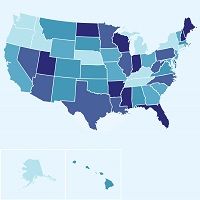Article
Legionnaires' Disease Outbreaks Continue Across the Country
Author(s):
A Legionnaires' Disease outbreak was confirmed in New York City earlier in the summer; however, investigations continue as additional deadly cases have been confirmed in other states.

A Legionnaires’ Disease outbreak was confirmed in New York City earlier in the summer; however, investigations continue as additional deadly cases have been confirmed in other states.
The New York City Department of Health and Mental Hygiene confirmed that Legionnaires’ Disease broke out in the South Bronx on July 10. The disease is a type of pneumonia that is caused by the bacterium Legionella, which grows in warm water. Five out of 17 cooling towers tested positive for the bacteria. A total of 116 people were sickened and 12 died from the infection. On August 10, the Opera House Hotel in the Bronx was deemed the source of the infection and officials declared that the outbreak was over on August 20. However, that isn’t the end of the deadly disease.
An investigation continues in California as prisoners at the San Quentin State Prison (SQ) have been diagnosed. On August 26, the first inmate was transported to an outside hospital where Legionnaires’ Disease was confirmed. As of September 2, six inmates have been diagnosed and another 95 were under observation for respiratory illness, according to an update from The California Department of Corrections and Rehabilitation (CDCR). Water usage has been limited until determined to be safe.
“Administrators at [SQ] continue to restore services to inmates as the investigation continues into the source of a Legionnaires’ disease outbreak,” the statement said.
Officials in Illinois are now addressing an outbreak all their own. On September 1, the Illinois Department of Public Health released a statement confirming that seven of 39 individuals diagnosed with Legionnaires’ Disease at the Illinois Veterans’ Home-Quincy had died. In addition, four cases in Quincy with one resulting in death were verified on September 2.
“We have thoroughly investigated each confirmed case for a connection with the outbreak, as well as any possible connection to one another. At this time, we have found no connections,” Jerrod Welch, administrator at the Adams County Health Department, said in a news release.
The Centers for Disease Control and Prevention (CDC) identified 10 things that healthcare workers need to know about Legionnaires’ Disease:
1. Diagnosing
- Clinical features: pneumonia, cough, fever
- Incubation period: two to 14 days after exposure
- Outcome: hospitalization common, fatal in 5 to 30% of cases
2. Who to Test
- Patients with severe pneumonia
- Patients who have failed antibiotic therapy
- Patients suspected of healthcare-associated pneumonia
- Patients who have traveled within two weeks before illness onset
- Patients with immunocompromised host with pneumonia
3. How to Test
- Culture
- Urine antigen
- Paired serology
- Direct fluorescent antibody stain
- PCR
4. Respiratory Specimen for Diagnosis
- Urine antigen testing may be convenient, however, isolating respiratory secretions (such as lung tissue, pleural fluid, or a normally sterile site) is important for investigation.
- Both clinical and environmental isolates are necessary.
5. Preferred Treatment
- Guidelines for when a patient is diagnosed with Legionnaires’ Disease
6. Ask Patients About Travel
- More than 20% of cases are linked to recent travel
- Difficult to detect in travelers because of < 5% attack rate
- Reporting travel-associated cases allows for earlier control of the illness
7. Frequency of Disease
- Cases are under-reported and diagnostic testing is under-used
- About 8,000 to 18,000 patients are hospitalized in the US each year for the disease
- Travel-associated, community-based, healthcare, and occupational outbreaks are common
8. Sources of Legionella
- Drinking water systems, whirlpool spas, and cooling towers (if these three conditions are present): transmission-heat, stasis, and aerosolization
- Found in natural, freshwater environments — but do not cause the disease due to insufficient amounts
9. Risk Factors
- Older than 50 years of age
- Diabetes
- Smoking
- Immune system disorders
- Systemic malignancy
- Renal or hepatic failure
- Exposure to whirlpool spas
- Recent travel — overnight outside of the home
- Recent repairs or maintenance on domestic plumbing
10. How to Report Diagnosis
- Find state health department and submit case report form


